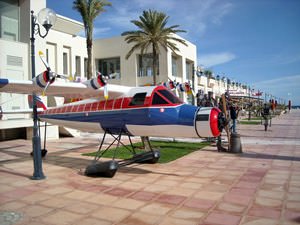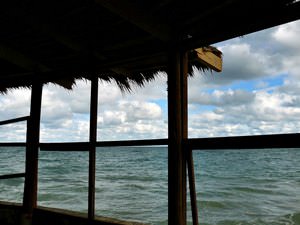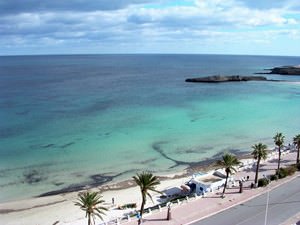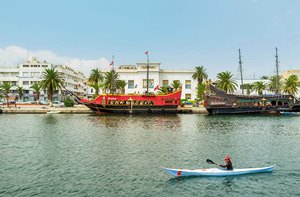 The transport infrastructure in Tunisia is quite well developed. The most popular form of public transportation is buses. Depending on the carrier’s company, the technical condition of the automobiles also varies. However, every tourist is generally guaranteed a safe and relatively comfortable travel on this type of transport. Also, within the cities, there are particular types of minibuses that stand out among all the others with regards to their color (white with a red horizontal stripe). They are known to commute passengers much faster than regular buses, and their ticket price is also cheaper. It should be noted that in the major cities of Tunisia there is the so-called TGM transport. In fact, it is a regular European tram. The local government regularly allocates money for the purchase of new trams and as a result, moving around the city using this kind of transport is quite comfortable.
The transport infrastructure in Tunisia is quite well developed. The most popular form of public transportation is buses. Depending on the carrier’s company, the technical condition of the automobiles also varies. However, every tourist is generally guaranteed a safe and relatively comfortable travel on this type of transport. Also, within the cities, there are particular types of minibuses that stand out among all the others with regards to their color (white with a red horizontal stripe). They are known to commute passengers much faster than regular buses, and their ticket price is also cheaper. It should be noted that in the major cities of Tunisia there is the so-called TGM transport. In fact, it is a regular European tram. The local government regularly allocates money for the purchase of new trams and as a result, moving around the city using this kind of transport is quite comfortable.
From a linguistic point of view, Tunisia is the most homogeneous and integral country of the modern day Maghreb. Almost all the locals can speak the …
Read further
Read further
 In the country also, water transport has received great development. Tourists often choose ferries that transport people from Tunisia to neighboring countries. The advantage of traveling by ferry is that it also provides you with the opportunity to transport your own car or other means of mobility. Also in the coastal areas you will find a variety of cruise ships and yachts, boats and sightseeing boats making regularly runs. The aviation sector has also received considerable development. Within the territory of the country, you will find a local airline called “Tuninter”. It specializes in conducting domestic flights. Flight within the country usually does not take more than 60 minutes. In addition, Tunisia has six air harbors, which are designed to receive foreign aircraft.
In the country also, water transport has received great development. Tourists often choose ferries that transport people from Tunisia to neighboring countries. The advantage of traveling by ferry is that it also provides you with the opportunity to transport your own car or other means of mobility. Also in the coastal areas you will find a variety of cruise ships and yachts, boats and sightseeing boats making regularly runs. The aviation sector has also received considerable development. Within the territory of the country, you will find a local airline called “Tuninter”. It specializes in conducting domestic flights. Flight within the country usually does not take more than 60 minutes. In addition, Tunisia has six air harbors, which are designed to receive foreign aircraft.
Main airports and avia transportation
Tunisia is dominated by a subtropical climate. The Mediterranean Sea is the main influence on the formation of weather conditions. Summer in the …
Read further
Read further
 Tunisia’s next international airport is Habib Bourguiba’s air harbor. Not long ago, this airport enjoyed full operations. It however now accepts only foreign charter flights. It is most convenient to fly to this airport if you plan to rest in Monastir, in Mahdia, or in Sousse. The airport of Djerba-Zarzis is considered the most southern of all the international air Harbors of Tunisia. Despite having only a fairly modest infrastructure, all that is necessary for offering passengers a good service has been made available within its territory. There is a small waiting room, decent cafes and bars, a small Duty Free shop, several shops with local products, as well as an ATM, a currency exchange office, and the branch of an international bank.
Tunisia’s next international airport is Habib Bourguiba’s air harbor. Not long ago, this airport enjoyed full operations. It however now accepts only foreign charter flights. It is most convenient to fly to this airport if you plan to rest in Monastir, in Mahdia, or in Sousse. The airport of Djerba-Zarzis is considered the most southern of all the international air Harbors of Tunisia. Despite having only a fairly modest infrastructure, all that is necessary for offering passengers a good service has been made available within its territory. There is a small waiting room, decent cafes and bars, a small Duty Free shop, several shops with local products, as well as an ATM, a currency exchange office, and the branch of an international bank.
Railway, bus, water and other transport
 The most common form of public transport in Tunisia are buses and trams. There are quite comfortable buses equipped with air-conditioners, shuttling between large cities of the country. Tickets can be purchased at newspaper kiosks or directly from the driver. In addition to one-off tickets, there are reusable tickets that provide you an opportunity to save a lot on transportation. You can also get cheaper tickets that allow you to ride on a minibus and a tram. The quality of the road surface in Tunisia is at a very high level, so it is possible to rent a car if you so desire.
The most common form of public transport in Tunisia are buses and trams. There are quite comfortable buses equipped with air-conditioners, shuttling between large cities of the country. Tickets can be purchased at newspaper kiosks or directly from the driver. In addition to one-off tickets, there are reusable tickets that provide you an opportunity to save a lot on transportation. You can also get cheaper tickets that allow you to ride on a minibus and a tram. The quality of the road surface in Tunisia is at a very high level, so it is possible to rent a car if you so desire.
Before Tunisia became an independent republic, it was considered an agrarian country. However, from 1959, the industrial base in the territory of …
Read further
Read further
 In Tunisia, you can call for a taxi. To move within the same city, you need to book a yellow taxi. If the trip is scheduled to another city however, the so-called “big taxi” is what you would need. The tariff is fixed; calculation with the driver is made according to the taximeter. Another great way to travel in Tunisia, and see the sights, is the railway transport. The network of tracks covers almost the whole country, while also passing near the coast. Both commuter and long-distance trains conduct regular runs.
In Tunisia, you can call for a taxi. To move within the same city, you need to book a yellow taxi. If the trip is scheduled to another city however, the so-called “big taxi” is what you would need. The tariff is fixed; calculation with the driver is made according to the taximeter. Another great way to travel in Tunisia, and see the sights, is the railway transport. The network of tracks covers almost the whole country, while also passing near the coast. Both commuter and long-distance trains conduct regular runs.
The best way to get acquainted with culture of Tunisia is to make excursions to its largest cities. In every of them travelers will find various …
Read further
Read further


